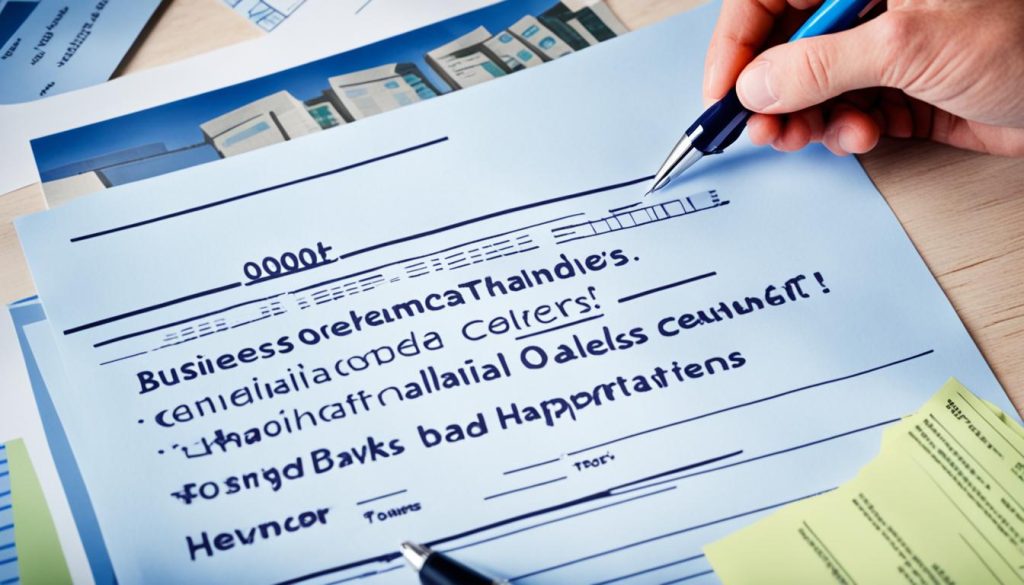In the world of business finance, having access to flexible funding can be crucial for managing cash flow and seizing opportunities. One such financial tool that many businesses rely on is the business overdraft. But what exactly is a business overdraft, and how does it work?
A business overdraft is a financial arrangement between a bank and a business that allows the business to withdraw more money than is currently in its account, up to a pre-agreed limit. It is a form of short-term borrowing that can help businesses manage fluctuations in cash flow or cover unexpected expenses.
In this article, we will explore the ins and outs of business overdrafts, including how they work, their benefits and drawbacks, and when they might be a suitable option for your business.
What Is a Business Overdraft?
A business overdraft is a valuable financial tool for businesses, providing them with the flexibility and convenience to manage their cash flow effectively. It serves as an overdraft facility on a business banking account, allowing businesses to access more funds than they have available. Whether it’s a small business overdraft or a larger overdraft facility, it offers businesses greater cash flow flexibility to settle invoices, cover overdue payments, purchase stock, manage unforeseen expenses, and address supply chain issues.
Understanding how a business overdraft works, its benefits, drawbacks, and the application process can help businesses make informed decisions about their financing options. In this comprehensive overview, we will explore all the essential aspects of a business overdraft, including how it works, its advantages and disadvantages, and alternative finance options available.
How Business Overdrafts Work?
A business overdraft is a financial tool that allows businesses to access additional funds when their account balance drops below zero. It provides flexibility and helps businesses manage their cash flow effectively. Let’s take a closer look at how business overdrafts work.
When a business applies for an overdraft, the bank sets a limit based on factors such as the business’s turnover and credit history. This limit determines the maximum amount that the business can borrow through the overdraft facility. Similar to a loan or a credit card, interest is charged on the borrowed amount until it is repaid.
Businesses can use the overdraft to cover various expenses, such as settling invoices, purchasing stock, or managing unforeseen expenses. The overdraft allows them to bridge temporary funding gaps and maintain a smooth supply chain, ensuring business operations continue uninterrupted.
Business Overdraft Interest Rates and Fees
The interest rates and fees associated with a business overdraft can vary depending on the bank and the amount borrowed. It’s important for businesses to carefully consider these costs when deciding to borrow through an overdraft.
| Interest Rates | Fees |
|---|---|
| Interest rates on business overdrafts are generally higher than other forms of business financing. The exact rate charged will vary depending on the bank and the business’s creditworthiness. | Fees can include an annual service fee based on the full limit amount, as well as fees for exceeding the overdraft limit or making additional drawdowns. |
It’s crucial for businesses to understand the complete cost structure of the overdraft and have a clear repayment plan in place. Repaying the outstanding balance promptly is essential to minimize interest costs and prevent the accumulation of unnecessary debt.

By utilizing a business overdraft effectively, businesses can access the funds they need to manage cash flow challenges and seize growth opportunities. However, it’s essential to consider the interest rates and fees associated with the overdraft facility, along with the business’s financial situation, before making borrowing decisions.
Benefits of a Business Overdraft
Business overdrafts offer several benefits to businesses. They provide flexibility in managing cash flow emergencies and short-term funding needs. Instead of facing financial constraints during unexpected situations, businesses can rely on an overdraft facility to bridge temporary funding gaps and maintain a smooth supply chain.
One of the major advantages of a business overdraft is its ability to help businesses settle invoices and cover overdue payments promptly. This ensures that the business maintains positive relationships with its suppliers and avoids any disruptions in the supply chain. By having access to additional funds, businesses can manage unforeseen expenses efficiently, enabling them to navigate unexpected financial challenges effectively.
Having an overdraft facility in place also gives businesses greater control over their cash flow. It provides a safety net, allowing businesses to maintain liquidity during times of uncertainty or when unforeseen expenses arise. This flexibility helps businesses avoid potential cash flow constraints that could hinder their day-to-day operations or growth initiatives.
Unlike a traditional loan, a business overdraft allows businesses to borrow only the amount they need, when they need it. This feature prevents unnecessary borrowing costs and ensures that businesses have access to funds on a flexible basis. Additionally, the interest charged on the borrowed amount is typically lower than other types of short-term financing options.
Overall, a business overdraft can provide businesses the peace of mind and financial flexibility they need to navigate temporary funding gaps, manage cash flow effectively, and address unexpected expenses. It allows businesses to seize opportunities promptly and maintain a steady flow of operations, contributing to their overall success and growth.

Drawbacks of a Business Overdraft
While business overdrafts can provide numerous benefits, it is important to consider the potential disadvantages before opting for this financing option.
Interest Rates and Increased Cost of Borrowing
One significant drawback of business overdrafts is that they are subject to interest rates. This means that businesses will incur additional costs in the form of interest on the borrowed amount. The interest rates can vary depending on the bank and the specific overdraft facility.
For businesses, this means that the overall cost of borrowing can increase significantly over time. It’s crucial to carefully consider the interest rates associated with the overdraft and assess whether the benefits outweigh the potential costs.
Penalty Fees and Credit Rating Impact
If businesses fail to repay the overdraft according to the terms and conditions set by the bank, it can result in penalty fees. These fees can further burden businesses and increase their financial obligations.
Moreover, failure to repay the overdraft on time can potentially affect the business’s credit rating. A negative impact on the credit rating makes it more challenging to obtain future credit or financing and may hamper the business’s growth and financial stability.
Risk of Losing Assets
Secured business overdrafts require businesses to pledge assets as collateral. While this provides security to the bank, it increases the risk for businesses. If the overdraft remains unpaid and the business defaults on its obligations, the bank may have the right to seize the assets pledged as collateral.
This puts businesses in a vulnerable position, as the loss of assets can significantly impact their operations and overall financial stability. It is crucial to carefully evaluate the risks associated with secured overdrafts before proceeding with this type of financing.
Higher Interest Rates for Unsecured Overdrafts
In contrast to secured overdrafts, unsecured overdrafts typically come with higher interest rates. The absence of collateral increases the risk for the bank, leading to higher interest charges for businesses.
Businesses considering unsecured overdrafts should be mindful of the higher interest rates and evaluate whether the benefits of the overdraft outweigh the increased borrowing costs.

When weighing the advantages and disadvantages of a business overdraft, businesses should consider their specific financial situation and needs. It’s important to assess the affordability, potential risks, and overall impact on the business’s financial health. Exploring alternative financing options and consulting with a financial advisor can provide valuable insights to make an informed decision.
Applying for a Business Overdraft
When businesses need access to additional funds, they can apply for a business overdraft with their current bank. The application process is generally straightforward and can be completed through various channels, including in-branch, over the phone, or online.
To qualify for a business overdraft, businesses must meet the eligibility criteria set by the bank. These criteria typically involve a review of the business’s financial history and creditworthiness. The bank may require details such as financial statements, business plans, and cash flow forecasts. The larger the desired overdraft amount, the more detailed information businesses may need to provide.
It’s important to note that each bank may have its own specific eligibility requirements and application process. Therefore, businesses should familiarize themselves with the requirements set by their chosen bank before applying for a business overdraft.

Business Overdraft Eligibility Criteria
The eligibility criteria for a business overdraft varies depending on the bank. However, common factors considered by most banks include:
- Business turnover
- Credit history
- Time in operation
- Profitability
- Industry sector
By meeting these criteria, businesses demonstrate their ability to manage and repay the overdraft, increasing their chances of approval.
Using a Business Overdraft Calculator
Before applying for a business overdraft, businesses may find it helpful to use a business overdraft calculator. These calculators can provide an estimate of the overdraft amount that businesses may be eligible for based on their financial information. They can also help businesses understand the potential costs associated with the overdraft, such as interest charges and fees.
Several banks, including HSBC and Barclays, offer business overdraft calculators on their websites. By using these calculators, businesses can better assess their financial needs and make informed decisions when applying for a business overdraft.
Business Overdraft Interest Rates and Fees
When considering a business overdraft, it is crucial for businesses to understand the interest rates and fees associated with this financing option. These costs can vary depending on the bank and the amount borrowed, so it’s important to carefully evaluate these factors when comparing different finance options.
Interest rates for business overdrafts can differ based on whether the overdraft is secured or unsecured. Secured business overdrafts, where businesses provide collateral, generally come with lower interest rates. On the other hand, unsecured overdrafts, which do not require collateral, typically have higher interest rates.
In addition to interest charges, businesses may encounter various fees when utilizing a business overdraft. These fees could include an annual service fee based on the full limit amount, as well as additional charges for any drawn amount. It’s essential for businesses to have a clear understanding of these fees to assess the overall cost of borrowing and make informed decisions.
To provide a clearer picture, here’s a breakdown of the typical costs associated with a business overdraft:
| Type of Fee | Description |
|---|---|
| Interest Rate | The rate charged on the borrowed amount, typically expressed as an annual percentage rate. This rate determines the cost of borrowing. |
| Annual Service Fee | A fixed fee charged annually based on the approved limit of the overdraft facility. |
| Drawn Amount Fee | A fee charged on each amount drawn from the overdraft facility. |
By considering these interest rates and fees, businesses can better evaluate the affordability of a business overdraft and determine whether it aligns with their financial objectives. It’s always advisable to consider multiple finance options and choose the one that best suits the specific needs of the business.
Managing Your Business Overdraft Effectively
Managing a business overdraft is essential for avoiding unnecessary costs and financial challenges. To effectively manage your business overdraft, consider the following strategies:
1. Regularly Monitor Cash Flow
Monitoring your business’s cash flow is crucial in determining when to utilize your overdraft facility. By keeping a close eye on your income and expenses, you can identify periods of increased financial strain and make informed decisions about when to access your overdraft.
2. Use Overdraft Only When Necessary
It’s important to use your business overdraft only when necessary to avoid unnecessary interest charges. Consider alternative financing options for short-term needs that may be more cost-effective, such as trade credit or invoice financing. Reserve your overdraft for emergencies or unforeseen expenses.
3. Develop a Repayment Plan
Having a clear repayment plan in place is crucial for efficiently managing your business overdraft. Aim to repay the borrowed amount as soon as possible to minimize interest costs. Prioritize repaying your overdraft alongside other financial obligations to reduce your overall debt burden.
4. Create a Budget and Cash Flow Forecast
Developing a budget and cash flow forecast can help you better manage your business overdraft. By understanding your projected income and expenses, you can anticipate potential cash flow gaps and plan accordingly. This proactive approach will enable you to effectively allocate your resources and meet your financial obligations.
By implementing these strategies, you can manage your business overdraft effectively and minimize the financial impact. Regularly assessing your cash flow, using the overdraft sparingly, and having a repayment plan in place will ensure that you utilize your overdraft facility wisely. Additionally, creating a budget and cash flow forecast will allow you to make informed financial decisions and maintain financial stability within your business.
Alternatives to Business Overdrafts
While business overdrafts can be a useful financial tool, they are not the only option for managing cash flow and funding needs. Businesses have a range of alternative finance options available, each offering its own advantages and suitability for specific situations.
Business Loans
Business loans provide a lump sum amount that can be used for various purposes, such as covering expenses, expanding operations, or investing in new equipment. Unlike business overdrafts, loans have fixed repayment terms and interest rates, allowing businesses to plan and budget their repayments accordingly.
Lines of Credit
Lines of credit are similar to business overdrafts in that they offer flexibility and ongoing access to funds. However, lines of credit often have lower interest rates and fees compared to overdrafts. Businesses can draw on the line of credit as and when needed, making it a convenient option for managing short-term funding requirements.
Trade Credit
Trade credit involves negotiating credit terms with suppliers, allowing businesses to defer payment for goods and services. This can provide valuable breathing space for businesses to generate revenue from their purchases before needing to pay their suppliers. Trade credit can help businesses manage their cash flow effectively, especially when dealing with large orders or long payment cycles.
Invoice Financing
Invoice financing, sometimes referred to as accounts receivable financing, enables businesses to access cash by selling their outstanding invoices to a third-party provider. This can help businesses bridge the gap between completing a sale and receiving payment. Invoice financing provides immediate funds and alleviates the strain on cash flow caused by lengthy payment terms.
Exploring these alternatives to overdraft facilities allows businesses to find options that best suit their specific needs and financial situation. By evaluating the advantages and suitability of each alternative, businesses can make informed decisions and choose the most appropriate financing option for their business.
Business Overdrafts Vs. Business Loans
When it comes to accessing funds, businesses have two popular options: business overdrafts and business loans. Both options have their advantages and considerations, so it’s essential for businesses to understand the differences before making a decision.
Business Overdraft: An overdraft provides businesses with increased flexibility and convenience. It allows access to funds on an as-needed basis, providing a safety net for managing cash flow fluctuations. Businesses only pay interest on the amount they use, which can be beneficial for short-term funding needs or unexpected expenses.
Business Loan: On the other hand, a business loan provides a lump sum amount that is repaid over a specified period. This may be more suitable for businesses with specific long-term projects or investments in mind. Loans often have fixed repayment terms, which can help businesses plan their finances and allocate resources accordingly.
The choice between a business overdraft and a loan depends on various factors such as the specific needs of the business, cash flow requirements, and the desired repayment structure. Here are some key considerations to help businesses make an informed decision:
- Flexibility: Business overdrafts offer more flexibility as funds can be accessed as needed. This can be useful for businesses with unpredictable cash flow or fluctuating funding requirements.
- Cost: Overdrafts typically have higher interest rates compared to loans. However, businesses only pay interest on the amount utilized, potentially reducing the overall cost.
- Repayment Structure: Loans have fixed repayment terms, allowing businesses to plan their budgets and cash flow accordingly. Overdrafts, on the other hand, provide more flexibility in repayment as businesses have the option to repay the borrowed amount whenever it suits them.
- Funding Amount: Business loans generally offer a higher funding amount compared to overdrafts. If a business requires a significant sum of money for a specific project, a loan may be more suitable.
Ultimately, the decision between a business overdraft and a loan depends on the specific needs and circumstances of the business. It’s important for businesses to carefully evaluate their cash flow requirements, repayment preferences, and the overall cost of borrowing before making a decision.
Considerations Before Using a Business Overdraft
Before applying for a business overdraft, there are several factors that businesses should carefully consider to ensure it aligns with their financial goals and circumstances. Here are some key things to keep in mind:
- Interest Rates: Understand the interest rates associated with the overdraft facility. Compare rates across different banks to determine the most competitive option.
- Fees: Be aware of any fees associated with the business overdraft, such as annual service fees or transaction fees. These charges can impact the overall cost of the facility.
- Repayment Terms: Evaluate the repayment terms and conditions set by the bank. Consider the affordability of the overdraft and assess whether your cash flow can accommodate the scheduled payments.
- Impact on Cash Flow: Analyze how the overdraft will impact your business’s cash flow. Ensure that borrowing from the overdraft will not strain your working capital or hinder other financial obligations.
- Alternative Finance Options: Explore alternative financing options and assess whether they may be more suitable for your business’s needs. Consider factors such as interest rates, repayment structures, and eligibility requirements.
By carefully considering these factors, businesses can make informed decisions about whether a business overdraft is the right financing option for them.
Conclusion
In conclusion, business overdrafts can be valuable tools for small businesses in managing cash flow and addressing short-term funding needs. They offer flexibility and convenience in accessing funds when required, providing a safety net for unexpected expenses or emergencies. However, it is crucial for businesses to carefully evaluate the costs, repayment terms, and their overall financial situation before opting for a business overdraft.
Business overdrafts can be a valuable financial tool if used strategically and managed effectively. Businesses need to carefully consider their specific needs, explore alternatives, and make informed decisions to ensure the overdraft aligns with their overall financial strategy. With proper planning and responsible usage, a business overdraft can provide the necessary flexibility and funding for businesses to thrive.
FAQs
Is a business overdraft a good idea?
Using a business overdraft can provide flexibility for managing cash flow fluctuations and covering short-term expenses. However, it’s essential to be mindful of associated fees and interest rates, as relying too heavily on an overdraft can lead to financial strain if not managed responsibly. Assess your business needs and cash flow patterns to determine if a business overdraft aligns with your financial strategy.
What is business loan overdraft?
A business loan overdraft is a financial product that allows businesses to access additional funds beyond their account balance. It provides a buffer for covering unexpected expenses or temporary cash flow shortages. Businesses can draw funds up to an approved limit and pay interest on the amount utilized.
How to qualify for a business overdraft?
To qualify for a business overdraft, banks typically assess factors such as the company’s credit history, financial performance, cash flow projections, and overall risk profile. Providing documentation like financial statements, business plans, and collateral may also be required. Demonstrating a stable revenue stream and responsible financial management can increase your chances of qualifying for a business overdraft.
Does a business overdraft affect credit score?
A business overdraft can impact your credit score if you default on payments or exceed the agreed overdraft limit. Timely repayment and responsible use of the overdraft can contribute positively to your credit history by demonstrating financial responsibility and reliability in managing debt.
How much overdraft can a business get?
The maximum overdraft amount a business can receive varies depending on factors like the company’s financial health, creditworthiness, and relationship with the bank. Banks may set a specific overdraft limit based on the business’s revenue, credit history, and collateral offered. It’s essential to discuss your funding needs and negotiate terms with your bank to determine the appropriate overdraft limit for your business.
Is having an overdraft good?
Having an overdraft can be beneficial for businesses to manage cash flow challenges, cover unexpected expenses, and navigate temporary financial setbacks. It provides a safety net for accessing funds quickly when needed, offering flexibility and liquidity to address operational needs. However, it’s crucial to use an overdraft prudently, monitor usage carefully, and repay the borrowed amount promptly to avoid excessive fees and interest charges.
How long does it take for an overdraft to be approved?
The approval timeline for a business overdraft can vary depending on the financial institution, the complexity of the application, and the completeness of the required documentation. In some cases, approval for a business overdraft can be processed within a few days, while more extensive reviews may take longer. It’s advisable to communicate transparently with your bank, submit all necessary paperwork promptly, and follow up on the status of your application to expedite the approval process.
Is an overdraft better than a loan?
The choice between an overdraft and a loan depends on your business’s financial needs, repayment capabilities, and risk tolerance. An overdraft provides flexibility for short-term cash flow management and immediate fund access, while a loan may offer structured repayment terms for larger investments or long-term financing. Consider your business goals, cash flow requirements, and cost implications to determine which option aligns best with your financial strategy.
Can I pay my overdraft off monthly?
Paying off your overdraft monthly is a common practice for businesses looking to manage their cash flow efficiently and avoid incurring unnecessary interest charges. By repaying the overdraft balance regularly, you can minimize interest costs, maintain financial discipline, and ensure that the overdraft facility remains available when needed in the future.
What happens if you never pay overdraft?
If you fail to repay your overdraft or exceed the agreed limit without authorization, your bank may charge penalty fees, increase interest rates, or take legal action to recover the outstanding amount.





